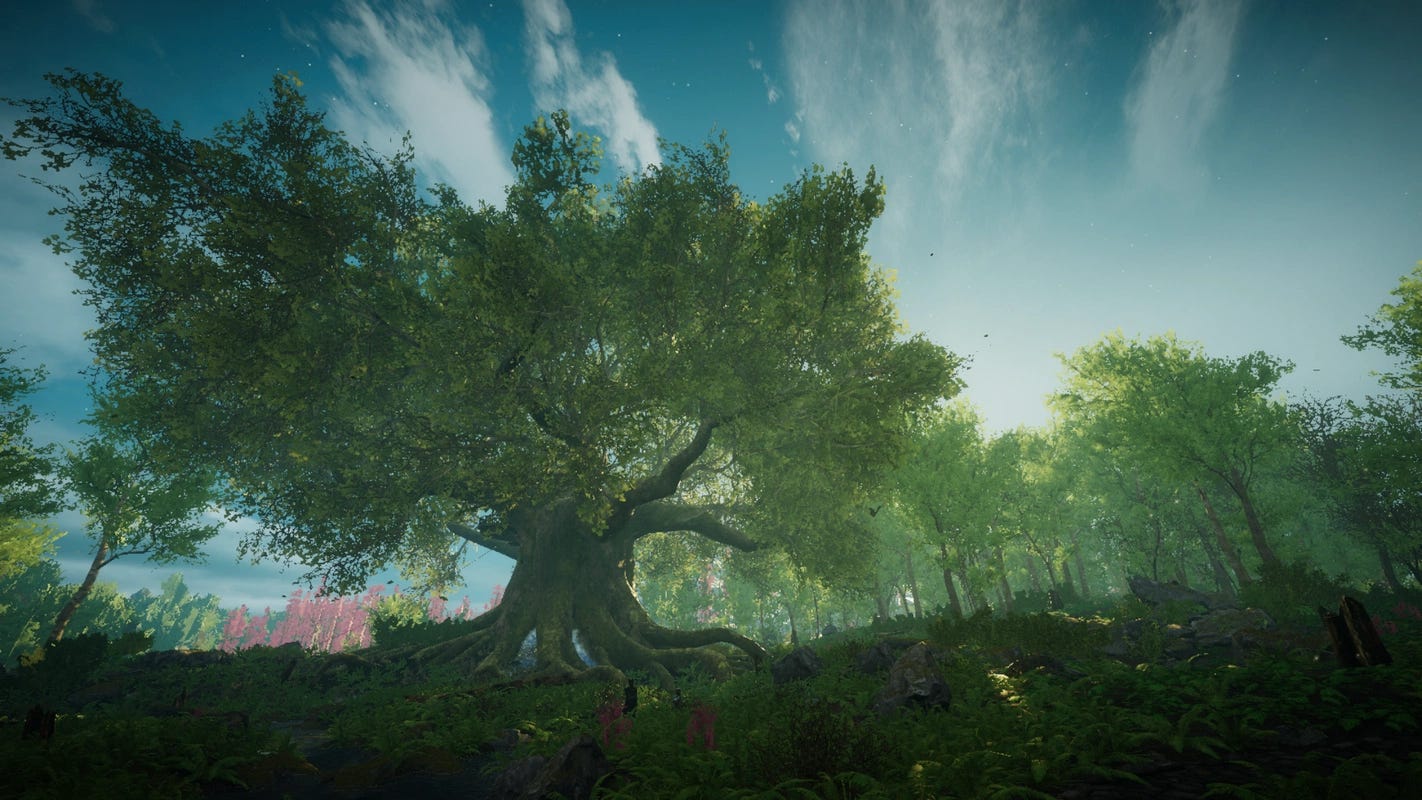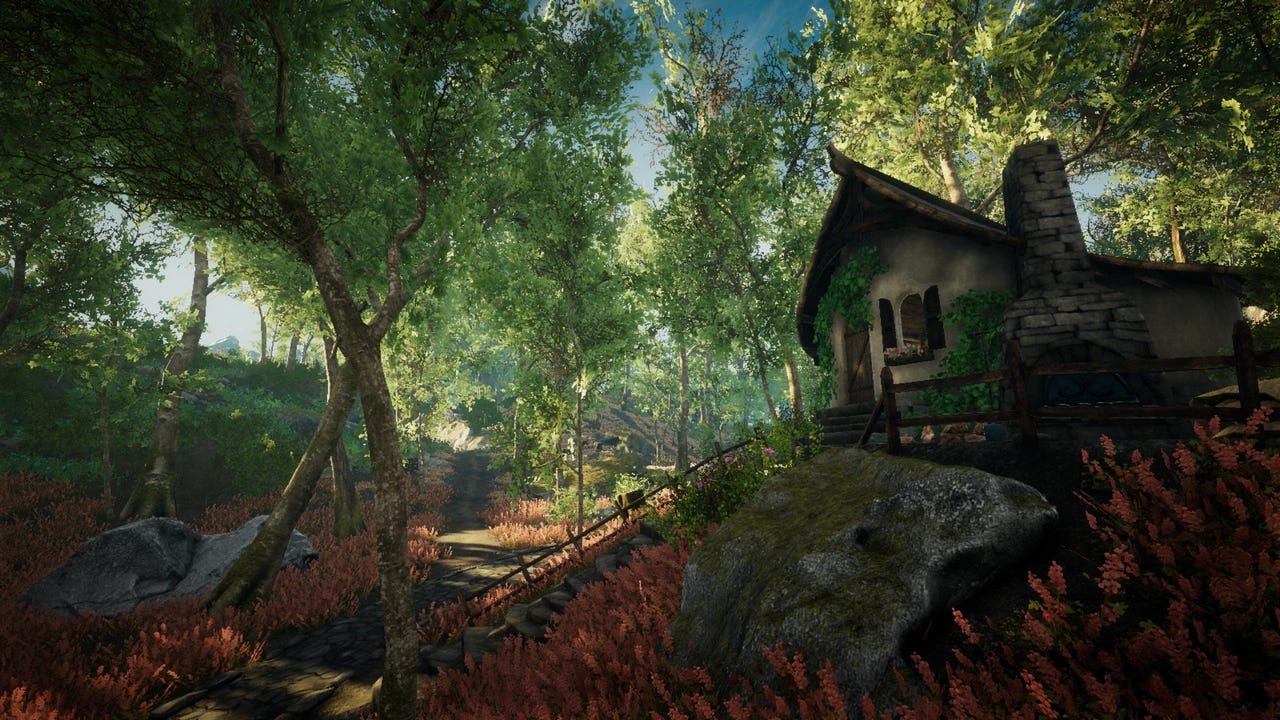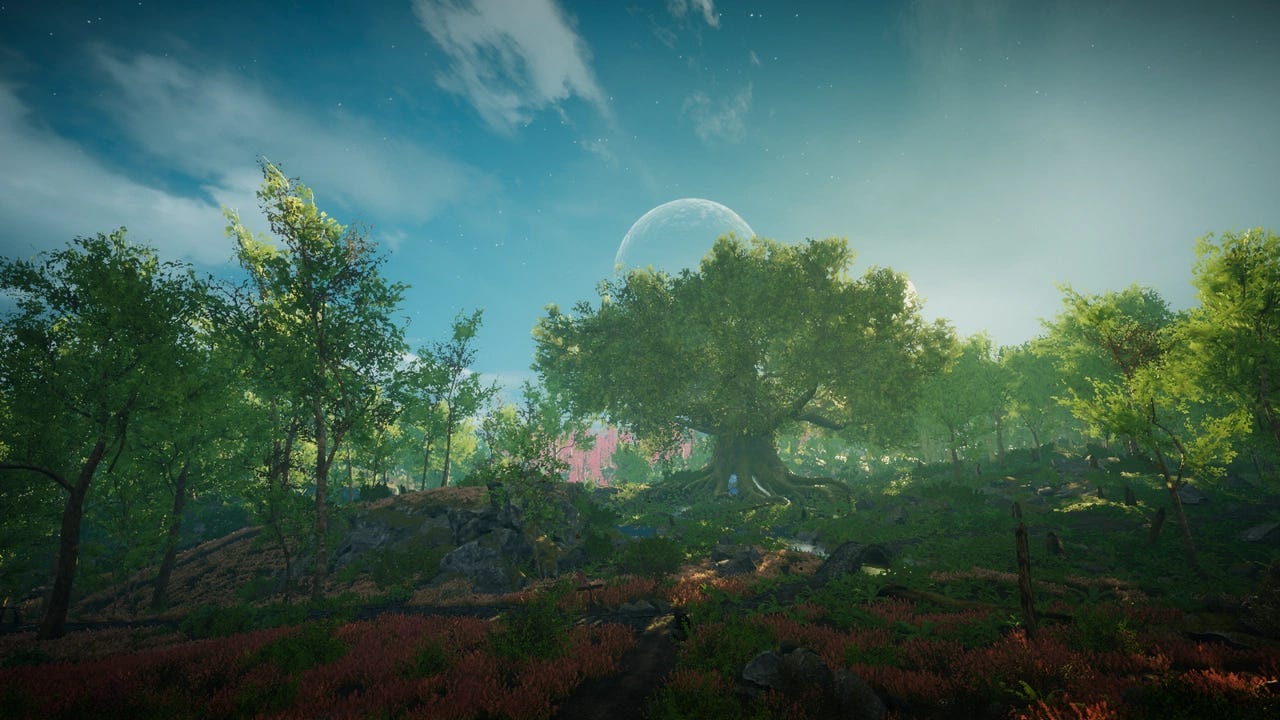Peaceful, wholesome games - Eastshade
Eastshade is a space for joy, and we need more of it.
You wake up on a traveling ship, and someone asks you to bring them a book. The book won't reveal any essential secrets about the world of Eastshade, and may seem more of a random idea to introduce the game. The task completed, the ship hits a reef and the adventure begins.
The scene is close to a microcosm for Eastshade: a simple goal, a linear path, a character which you do not get to know, a lack of grander context and characterization. The brief intro is welcome and intentional, and Eastshade maintains its brevity throughout, rarely delving into complex lore.
But the adventure is mesmerizing because games like Eastshade - peaceful, non-violent - rarely stand on complex design. Instead, they create worlds of fairytale beauty and contemplative exploration built on simplicity and minimalism. To be appreciated, Eastshade must be accepted on its own terms - not simply as game meant to stimulate adrenalin or provide achievements, but an invitation to lose yourself in a world built on innocence.
Wholesome level: Great. Eastshade begins with a sad premise but progresses to a playground of wholesomeness and dreamy wandering.
For all its gleefulness, Eastshade begins with a sad story: the protagonist's mother has passed away, and your task is to cherish her legacy by painting her favorite places around the island.
This sad premise goes against most of the game's plot as a relaxation sim, but imbues Eastshade with dimension and humanity. Sad in the beginning, but turning hopeful by fulfilling the request of a loved one.
Another glitch in the peaceful road is an early encounter which may posit that a kid is in danger of jumping off a building with no safety. The game plays the event for a laugh, but the implications are best avoided in a fairytale like Eastshade.
Space for contemplation
To reach the states Eastshade wants - rest, joy, contemplation - you need a low-stress environment and a topic of high-engagement, something you love. Eastshade follows its friendly approach to joy thematically and gameplay-wise, balancing a beautiful open-world with simple mechanics and basic simulation and crafting elements.
The game provides most of this environment, but sometimes it works against itself through an uneven difficulty: the world opens up gradually until you complete certain tasks, fast-travel takes a while to unlock, and there's no objective markers to help the player.
Most quests follow along with simpler themes: some people want you to paint various natural elements, a baker is in love and needs help to confess to her crush; a balloon owner gets no business because people don't know about her venture (though her huge balloon awaits next to the biggest city.)
Alongside the stress created by difficulty, another hurdle is the explicit effort to not expand the world and its lore. Eastshade is a memorable game, but unlike other cult classics, it's mostly so while playing. The cause is easy to grasp: the lack of in-depth characterization and worldbuilding.
The world is gorgeous, beautiful to look at, but without more support from writing it seems insubstantial, as if the illusion is meant to be forgotten when the adventure stops. This is not a "hard" critique for the game - plenty of good games lack complex characterization, casual ones more so - but a desire to know more about Eastshade, about its world and culture.
Because of its simplicity, Eastshade can be less memorable than other indie cult games. Firewatch, for example, another peaceful indie, shares Eastshade's simplicity in design. Firewatch's tone and themes are dramatic, but its short-lived mystery shines thanks to stellar writing (and perpetual paranoia).
As a standard bonus for nonviolent games, Eastshade's peaceful approach to questing makes it friendly to beginners. There's no difficulty gatekeeping in solving quests, apart from how much the player chooses to explore and complete. Progression avoids grinding by skipping skills, instead relying on exploration and completing quests (a fair amount of fetchy ones, but expected with minimalist quest design.
Eastshade reminds me of Skyrim like this: lore bits are spread throughout, but not enough to shape a substantial world. Peppering worldbuilding everywhere is the right way, but here Eastshade should provide more density.
Questing peacefully
Even so, there are honest efforts to expand the world.
One adventure involves consuming dream-inducing drugs - well, tea. This sort of quest creates dimension - its plot lingers for a while, requiring a bit of investigation, time to take in the world and be excited for what we'll discover.
The premise of the quest is intriguing because it involves competing factions, which in turn give the world personality. No major revelations are found at the conclusion, but Eastshade would've benefited by playing with more quests grander in scope, stretching across the story.
***
We get an immersive physical way to define ourselves in Eastshade via painting. Beyond quest goals, what you choose to paint speaks about your sensibilities.
I love this type of activity in games - painting, photography - because it's easy to understand, requires no complex mechanics, and is an accessible way for self-expression. Better, Eastshades integrates painting in quests and gameplay to encourage exploration by rewarding inspiration.
Like most open-world games, Eastshade is at its best not in the beginning, not toward the end, but in the mid-game. When you explore and complete tasks not to gain achievements but to know the world, when you retreat for the night or wander and stop to enjoy the beauty of the sunset, here Eastshade reveals itself most naturally.
These are the moments which define the protagonist not necessarily as hero but as a natural part of the world. Exploring in this more organic way helps to mitigate Eastshade's lack of in-depth lore because it creates a natural link between explorer and cosmos.
Many games with potential for contemplation and meditation miss this nigh-essential feat. Bethesda games, for example, have bare mechanics for encouraging wanderlust, getting lost in the beauty of their landscape.
Their Fallout games fair better because they offer experience for discovering new places, but The Elder Scrolls has no mechanics to encourage slowing down to contemplate beauty, even with the risk of needless gamification.
Eastshade supports this search for contemplation, meditation, wandering by offering "experience" - inspiration as resource for paintings - for discovering interesting locations or completing tasks. It's a naturalist means to support wanderlust.
Even so, I wish it would encourage contemplation more - for example, be inspired simply by watching the sunrise, sunset, or horizon. More lateral design and systemic, gameplay-driven means to gain experience.
*
But Eastshade's friendly spirit makes it easier to accept its shortcomings. Open-world games which take themselves seriously must support their cosmos with a plethora of worldbuilding, otherwise they unintentionally become theme-parks instead of natural spaces.
Eastshade makes its lack of worldbuilding easier to overlook - there's no complex politics or impending doom, what you see is what you get in a simpler way than action games, including other wandering sims.
The intrigue gets better after about half-way, when you have to play detective. As with the aforementioned "dream cult", the investigation stands out because it requires deductive work, and helps make Eastshade a world where intrigue happens naturally.
This is where storytelling is at a strong point, regardless of medium and genre, thanks to interconnected elements and characters which create a living world. Fans of TES: Oblivion who remember the quest Whodunit? will appreciate this increase in narrative complexity. Eastshade, like Oblivion, would have been better with more such quests.
In brief comparison, another so-called walking sim such as Skyrim has the advantage of a bigger world, a hefty amount of hand-crafted quests and the ability to roam freely, potentially forever. But these are different kinds of "walking sims": one focused on perpetual adventure and stimulation, the other meant to induce relaxation and joy.
Skyrim is memorable partly due to sheer size - there's more of everything, a greater chance to find a stimulating experience. Eastshade may be seen as Skyrim in miniature - open-world, quirky characters and quests, basic sim elements, minus the violence.
Eastshade also has the advantage of peacefulness, a focus on empathy and offering help. In standard open-world adventures violence plays a pivotal role, while Eastshade thrives on wholesomeness.
Not wanting to say goodbye
Games like Eastshade cannot be judged by their standard limitations alone. Their purpose is not to be engaging mechanically or to impress with dramatic stories, but to explore peaceful worlds of perpetual respite.
Even so, I wish Eastshade could grow in scope: to have a more substantial world, more complex characters and narrative design. I cannot shake the feeling of wanting more from it precisely because it accomplishes its purpose well.
When the main goal is done and it's time to leave Eastshade, you feel joy, nostalgia, and a longing for complexity - at the least, the need to spend more time in its world, to know more about its people and culture. Like Skyrim, disappointment with Eastshade is a desire for more, not always in terms of content, but in terms of storytelling.
To keep the impression of a perpetual vacation requires a serene balance of themes and worldbuilding. If Eastshade would get a sequel, I'd hope it grows in complexity, but I would not fault it if it does not.
Its purpose is not to provide action thrills, but to inspire and relax - and for a few hours of wandering, it does it with glee.
Game design lessons
Simplicity
Part "genre" (peaceful exploration game), part limited resources, Eastshade puts its resources where they matter. Open-world map with limited scope, no skills, simple dialogue, mostly simple quests, a welcome painting mechanic. I do hope a sequel / spinoff works with more complex narrative design, though.
Painting
Artistic endeavor and gameplay goal. You can paint anywhere you wish. Some paintings are needed to advance quests and some will earn a pretty glowstone (currency, money, cash).
Painting helps characterization and self-expression. Beside completing goals, it's a pleasant way to introduce people to art as diegetic means of taking screenshots.
Diegetic map
To find your way, you must listen to directions and buy a map. A simple way to increase immersion, physicality and make the player pay attention.
Visual beauty
Like other open-world games, Eastshade knows the value of beautiful landscapes to encourage exploration and admire the view. Combine this beauty with the painting mechanic for a gameplay motivation to rest and enjoy the world.
Immersive-Sim lite
Sim elements in Eastshade are simple and effective. Some characters have schedules and move locations depending on player choice. The basic crafting system encourages exploration via resource gathering and making items needed for progression. No skills or experience beyond inspiration for painting.
A serene soundtrack
It may be trite to praise the soundtrack, but Eastshade is a game with a heavenly arrangement. Violin, strings, flute and others are traditional instruments for fantasy, but rarely do they make such beguiling music as here.
There's a fine line between ambient music which supports exploration and needless audio drama. Eastshade's composer knows to let the world breathe on its own while creating one of the most memorable soundtracks in games.
How to make Eastshade more joyful
Peaceful games should be accessible mechanically. A good degree of difficulty - locked play areas, limited skill use, resources gathering - makes sense to provide impetus for progression, but the focus should stay on supporting relaxation. The more obstacles the game introduces, the bigger the chance for flow to break and stress to take over.
Difficulty works as gameplay mechanic to slow progress and give action meaning, but might alienate players looking for a relaxed trip without constraints.
Eastshade's difficulty is gentle enough, but it can do more to reduce mental load, be friendlier mechanically, reduce time padding, and fit better within a peaceful sim:
Provide a means for faster travel sooner
Allow the player to buy necessary items alongside crafting
Offer more opportunities to gain inspiration
Allow more ways to complete quests to support player freedom
Provide an optional objective marker. Yes, some people need it, and it fits Eastshade's philosophy of accessibility.
Bring a touch of personality. Eastshade has a strong identity, but it often feels insubstantial because of simplistic dialogue. More interesting prose would give its culture a distinct personality and make it more memorable.
Skip the jumping puzzles. Non-violent games - especially first-person - should avoid platforming sections. Jumping puzzles are better with mechanics such as ledge-grabbing, which Eastshade lacks.



